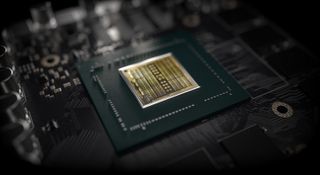A new Gigabyte filling with the Eurasian Economic Commission (EEC) hints that, in addition to the GeForce GTX 1660 Super, Nvidia could be preparing the GeForce GTX 1650 Super as well to face AMD's upcoming Radeon RX 5500.

It's easy to see why Nvidia feels intimidated by the the Radeon RX 5500 since the graphics card allegedly sports the same core count as the GeForce GTX 1660. Word is spreading that Nvidia will equip the GeForce GTX 1660 Super with faster GDDR6 memory clocked at 14 GBps as opposed to the GDDR5 memory running at 8 GBps on the original GeForce GTX 1660. We're not sure if the memory upgrade alone would be enough to give the GeForce GTX 1660 Super the edge over the Radeon RX 5500. Obviously, Nvidia has more reason to worry about the GeForce GTX 1650, which would unquestionably fall behind the Radeon RX 5500.
| Row 0 - Cell 0 | GeForce GTX 1650 | GeForce GTX 1650 Super* | GeForce GTX 1660 | GeForce GTX 1660 Super* |
| Architecture (GPU) | Turing (TU117) | Turing (TU117) | Turing (TU116) | Turing (TU116) |
| Shading Units | 896 | 1,024 | 1,408 | 1,408 |
| Single-Precision Performance | 2.984 TFLOPS | ? | 5.027 TFLOPS | 5.027 TFLOPS |
| Texture Units | 56 | 64 | 88 | 88 |
| Base Clock Rate | 1,485 MHz | ? | 1,530 MHz | 1,530 MHz |
| GPU Boost Rate | 1,665 MHz | ? | 1,785 MHz | 1,785 MHz |
| Memory Capacity | 4GB GDDR5 | 4GB | 6GB GDDR5 | 6GB GDDR6 |
| Memory Clock | 8 Gbps | ? | 8 Gbps | 14 Gbps |
| Memory Bus | 128-bit | ? | 192-bit | 192-bit |
| Memory Bandwidth | 128 GBps | ? | 192 GBps | 336 GBps |
| ROPs | 32 | 32 | 48 | 48 |
| L2 Cache | 1MB | ? | 1.5MB | 1.5MB |
| TDP | 75W | ? | 120W | 120W |
| Transistor Count | 4.7 billion | 4.7 billion | 6.6 billion | 6.6 billion |
| Die Size | 200 mm² | 200 mm² | 284 mm² | 284 mm² |
| Price | $149 | ? | $219 | ? |
*Specifications are unconfirmed.
In order to keep the GeForce GTX 1650 competitive, Nvidia could resort to playing its Super card once again. Nevertheless, there is a good chance that the Nvidia just rebranded the GeForce GTX 1650 Ti, which was spotted back in April, to the GeForce GTX 1650 Super. Gigabyte's recent listing and Asus' previous listing agree that both graphics cards rock 4GB of unspecified memory.
Let's assume that the GeForce GTX 1650 Super is the GeForce GTX 1650 Ti for a minute. The GeForce GTX 1650 Super could use the full TU117 die, meaning it might have up to 1,024 CUDA cores at its disposal. The graphics card will sit comfortably between the GeForce GTX 1650 and GeForce GTX 1660, but we don't expect it to challenge the Radeon RX 5500.

Gigabyte, for one, plans to exploit the GeForce GTX 1660 Super and GTX 1650 Super to the fullest extent. The manufacturer listed up to 12 different custom models for each SKU. You can expect graphics card from Gigabyte's Gaming, WindForce and Mini-ITX product lines. Surprisingly, there was no mention of any Aorus models. Nonetheless, not all the models will make it to the market though.
| GeForce GTX 1650 Super | GeForce GTX 1660 Super |
| GV-N165SGAMING OC-4GD | GV-N166SAORUS-6GD |
| GV-N165SWF2OC-4GD | GV-N166SGAMING OC-6GD |
| GV-N165SOC-4GD | GV-N166SGAMINGOC WHITE-6GD |
| GV-N165SOC-4GL | GV-N166SWF2OC-6GD |
| GV-N165SIXOC-4GD | GV-N166SOC-6GD |
| GV-N165SGAMING -4GD | GV-N166SIXOC-6GD |
| GV-N165SWF2-4GD | GV-N166SGAMING-6GD |
| GV-N165SD6-4GD | GV-N166SGAMING WHITE-6GD |
| GV-N165SD6-4GL | GV-N166SWF3-6GD |
| GV-N165SIX-4GD | GV-N166SWF2-6GD |
| GV-N165S-4GD | GV-N166SD6-6GD |
| GV-N165S-4GL | GV-N166SIX-6GD |
The Radeon RX 5500 is rumored to launch on October 7 while the GeForce GTX 1660 Super and GeForce GTX 1650 Super supposedly arrive next month. Needless to say, the mid-range graphics card market is about to get a lot more interesting.
Stay on the Cutting Edge
Join the experts who read Tom's Hardware for the inside track on enthusiast PC tech news — and have for over 25 years. We'll send breaking news and in-depth reviews of CPUs, GPUs, AI, maker hardware and more straight to your inbox.

Zhiye Liu is a Freelance News Writer at Tom’s Hardware US. Although he loves everything that’s hardware, he has a soft spot for CPUs, GPUs, and RAM.
-
warezme These are all sad incremental cards with big names that don't mean anything. GTX? no, Super? No. There was a time only the highest end series was GTX and Super meant something. This ain't it.Reply -
King_V I'm starting to wonder, are these starting to overlap and step over each other? I mean, is Nvidia trying to fill every segment, both real and imaginary?Reply
My assumption is that, from lowest to highest performance. it will be as follows:
1650
1650 Super
1650 Ti
1660
1660 Super
1660 Ti
But at this point, I'm not sure of my assumptions - I mean . . how far apart are these going to be from each other? Or, are the Super cards going to outperform the Ti? Are the "plain Jane" versions (the ones that are non-Super and non-Ti) going away?
I'm a little confused as to what strategy, if any, exists here, other than a sort of semi-coherent flooding tactic. I get what the goal is, I just don't get the methodology.
Most Popular


